Lakhmir Singh & Manjit Kaur: The Human Eyes And The Colorful World, Solutions- 3 | Science Class 10 PDF Download
Page No:280
Question 21: What are the two most common defects of vision (or defects of eye) ? How are they corrected ?
Solution : The two most common defects of vision are myopia and hypermetropia. Myopia can be corrected by using a concave lens and hypermetropia can be corrected by using a convex lens.
Question 22: Differentiate between myopia and hypermetropia. What type of spectacles should be worn by a person having the defects of myopia as well as hypermetropia ? How does it help ?
Solution : In myopia, a person can see nearby objects clearly but cannot see distant object clearly. In hypermetropia, a person can see distant objects clearly but cannot see nearby objects clearly.
A person having the defects of myopia as well as hypermetropia should wear spectacles having bifocal lenses in which upper part consists of concave lens and lower part consists of convex lens.
The upper part corrects myopia and the lower part corrects hypermetropia.
Question 23: Name the defect of vision which can be corrected by a converging lens. Show dearly by a ray diagram how the lens corrects the defect.
Solution : Hypermetropia can be corrected by a converging lens.
Correction of hypermetropia is given in the following diagram:
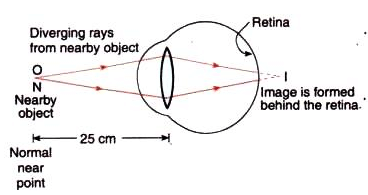
(a) In a hypermetropic eye, the image of nearby object lying at normal near point N (at 25 cm) is formed behind the retina.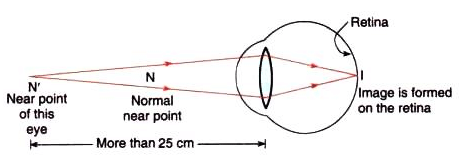
(b) The near point N'of hypermetropic eye is farther away from the normal near point N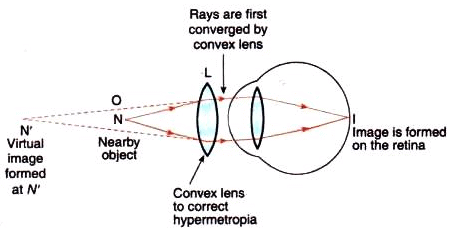
(c) Correction of hypermetropia. The convex lens forms a virtual image of the object (lying at normal near point N) at the near point N’ of this eye.
Question 24: Name the defect of vision which can be corrected by a diverging lens. Show clearly by a ray diagram how the lens corrects the defect.
Solution : Myopia can be corrected by a diverging lens. Correction of myopia is given in the following diagram:

(a) In a myopic eye, image of distant object is formed in front of the retina (and not on the retina)
(b) The far point (F) of a myopic eye is less than infinity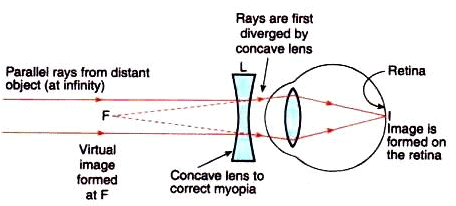
(c) Correction of myopia. The concave lens placed in front of the eye forms a virtual image of distant object at far point (F) of the myopic eye
Question 25: Explain with the help of labelled ray diagram, the defect of vision called myopia and how it is corrected by a lens.
Solution : Myopia or short sightedness is that defect of vision due to which a person cannot see the distance objects clearly (though he can see the nearby objects clearly). This eye defect can be corrected by using a concave lens.
Myopic eye and its correction is given in the following diagrams

(a) In a myopic eye, image of distant object is formed in front of the retina (and not on the retina)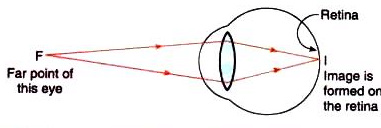
(b) The far point (F) of a myopic eye is less than infinity
(c) Correction of myopia. The concave lens placed in front of the eye forms a virtual image of distant object at far point (F) of the myopic eye
Question 26: Explain with the help of labelled ray-diagram, the defect of vision called hypermetropia, and how it is corrected by a lens.
Solution : Hypermetropia (or long-sightedness) is that defect of vision due to which a person cannot see the nearby objects clearly (though he can see the distant object clearly). This eye defect can be corrected by using a convex lens.
Hypermetropic eye and its correction is given in the following diagrams:
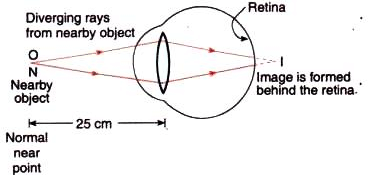
(a) In a hypermetropic eye, the image of nearby object lying at normal near point N (at 25 cm) is formed behind the retina.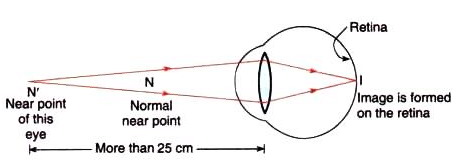
(b) The near point N' of hypermetropic eye is farther away from the normal near point N
(c) Correction of hypermetnopia. The convex lens forms a virtual image of the object (lying at normal near point N) at the near point N’ of this eye.
Question 27: A person suffering from the eye-defect myopia (short-sightedness) can see clearly only up to a distance of 2 metres. What is the nature and power of lens required to rectify this defect ?
Solution : The person needs a concave lens to rectify this defect.
Calculation of power of the lens:
Here, far pant of myopic eye = 2m
The object kept at infinity can be seen dearly if the image of this object is formed at 2m.
So, object distance, u = ∞ Image distance, v = 2m

Question 28: The near-point of a person suffering from hypermetropia is at 50 cm from his eye. What is the nature and power of the lens needed to correct this defect ? (Assume that the near-point of the normal eye is 25 cm).
Solution : The person needs a convex lens to rectify this defect.
Calculation of power of the lens:
This hypermetropic eye can see the nearby object kept at 25 cm clearly if the image is formed at its own near point i.e. 50 cm.
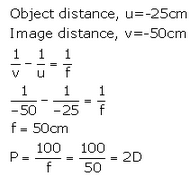
Question 29: A person needs a lens of power, – 5.5 dioptres for correcting his distant vision. For correcting his near vision, he needs a lens of power, +1.5 dioptres. What is the focal length of the lens required for correcting
- distant vision, and
- near vision ?
Solution :
- For distant vision:
P = -5.5D
P = 1/f
f = 1/P = 1/(-5.5) = -0.1818 m = -18.18cm - For Near Vision:
P = 1.5D
P = 1/f
f = 1/P = 1/1.5 = 0.6666 = 66.66 cm
Question 30: What is presbyopia ? Write two causes of this defect. Name the type of lens which can be used to correct presbyopia.
Solution : Presbyopia is that defect of vision due to which an old person cannot see the nearby objects clearly due to loss of power of accommodation of the eye.
Causes: Gradual weakening of the ciliary muscles and diminishing flexibility of the eye lens.
It can be corrected by using convex lenses.
Question 31: When is a person said to have developed cataract in his eye ? How is the vision of a person having cataract restored ?
Solution : A person is said to have developed cataract when the eye lens becomes progressively cloudy resulting in blurred vision.
The vision of a person having cataract can be restored after getting surgery done on the eye having cataract. The opaque lens is removed from the eye by surgical operation and a new artificial lens is inserted in its place.
Question 32: Fill in the following blanks with suitable words :
A person is short-sighted if his eyeball is too……………. Spectacles with a………… lens are needed. A person
is long-sighted if his eyeball is too……………. Spectacles with a …………. lens are needed. These focus light
rays exactly on to the………..
Solution : long, concave, short, convex, retina
Question 33: (a) What is short-sightedness ? State the two causes of short-sightedness (or myopia). With the help of ray
diagrams, show :
- the eye-defect short-sightedness.
- correction of short-sightedness by using a lens.
(b) A person having short-sight cannot see objects clearly beyond a distance of 1.5 m. What would be the nature and power of the corrective lens to restore proper vision ?
Solution : (a) Short Sightedness is that defect of vision due to which a person can see nearby objects clearly but cannot see distant objects clearly.
Causes:
1. Excessive curvature of the eye lens
2. Elongation of the eyeball
Ray diagram for:
(i) eye-defect short sightedness

In a myopic eye. image of distant object is formed in front of the retina (and not on the retina)

The far point (F) of a myopic eye is less than infinity
(ii) Correction of short-sightedness by using a lens

Correction of myopia. The concave lens placed in front of the eye forms a virtual image of distant object at far point (F) of the myopic eye
(b) Concave lens should be used to restore proper vision.
Calculation of power:
Here, far point of myopic eye = 1.5m
The object kept at infinity can be seen dearly if the image of this object is formed at 1.5m.
So, object distance, u = ∞
Image distance, v = 1.5m

Question 34: (a) What is long-sightedness ? State the two causes of long-sightedness (or hypermetropia). With the help of ray diagrams, show :
- the eye-defect long-sightedness.
- correction of long-sightedness by using a lens.
(b) An eye has a near point distance of 0.75 m. What sort of lens in spectacles would be needed to reduce the near point distance to 0.25 m ? Also calculate the power of lens required. Is this eye long-sighted or shortsighted ?
(c) An eye has a far point of 2 m. What type of lens in spectacles would be needed to increase the far point to infinity ? Also calculate the power of lens required. Is this eye long-sighted or short-sighted ?
Solution : (a) Long-sightedness is that defect of vision due to which a person cannot see the nearby objects clearly but he can see the distant objects clearly.
Causes:
1. Focal length of the eye lens is too long.
2. The eyeball has become too small.
Ray diagram for:
(i) eye-defect long-sightedness
Page No:281
Question 47: In a certain murder investigation, it was important to discover whether the victim was long-sighted or short-sighted. How could a detective decide by examining his spectacles ?
Solution : If the spectacle lenses are convex, the person was long sighted and if the spectacle lenses are concave, the person was short sighted.
Question 48: The picture given here shows a person wearing ‘half-moon’ spectacles. What sort of eye-defect do you think he has ? Why are these particular spectacles useful to him ?
Solution : Half moon spectacles are used for reading. so, the person has long-sightedness.
These particular spectacles are useful to him since the convex lenses of spectacles form the image of nearby object (like a book in hand) at the near point of his eye.
Question 49: A short-sighted person has a near point of 15 cm and a far point of 40 cm.
(a) Can he see clearly an object at a distance of:
(i) 5 cm ? (ii) 25 cm ? (iii) 50 cm ?
(b) To see clearly an object at infinity, what kind of spectacle lenses does he need ?
Solution : (a) (i) No, (ii) Yes, (iii) No
(b) Concave lenses
Question 50: The near point of a long-sighted person is 50 cm from the eye.The near point of a long-sighted person is 50 cm from the eye.
(a) Can she see clearly an object at :
(i) a distance of 20 cm ?
(ii) at infinity ?
(b) To read a book held at a distance of 25 cm, will she need converging or diverging spectacle lenses ?
Solution : (a) (i) No, (ii) Yes
(b) Converging lenses
Question 51: A person can read a book clearly only if he holds it at an arm’s length from him. Name the defect of vision :
(a) if the person is an old man
(b) if the person is a young man
Solution : (a) Presbyopia
(b) Hypermetropia
Page No:282
Question 1: How much is our field of view :
(a) with one eye open ?
(b) with both eyes open ?
Solution : (a) About 150o
(b) About 180o
Question 2: Which of the following have a wider field of view ?
(a) Animals having two eyes on the opposite sides of their head.
(b) Animals having two eyes at the front of their head.
Solution : Animals having two eyes on the opposite sides of their head.
Question 3: Out of animals of prey and predators, which have their eyes :
- at the front of their head ?
- on the opposite sides of their head ?
Solution :
- Predators
- Animals of prey
Question 4: State whether the following statement is true or false :
Rabbit has eyes which look sideways.
Solution : True
|
80 videos|569 docs|80 tests
|
FAQs on Lakhmir Singh & Manjit Kaur: The Human Eyes And The Colorful World, Solutions- 3 - Science Class 10
| 1. What is the function of the human eyes? |  |
| 2. How do our eyes perceive color? |  |
| 3. What is the role of the lens in the human eye? |  |
| 4. How does the eye adapt to different lighting conditions? |  |
| 5. Can the human eye see all colors? |  |
















